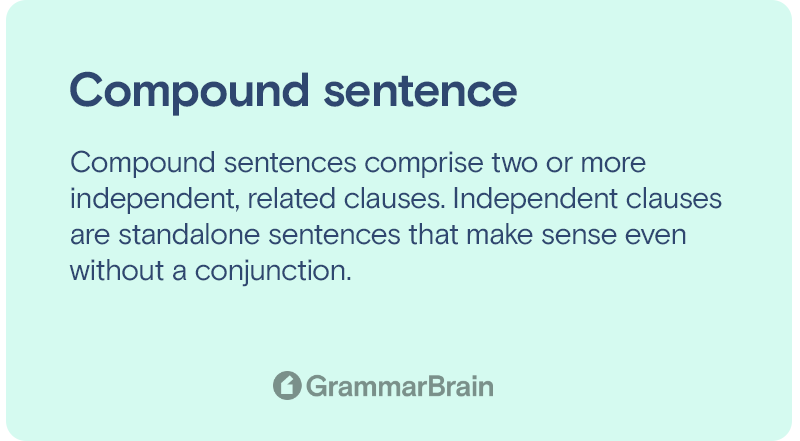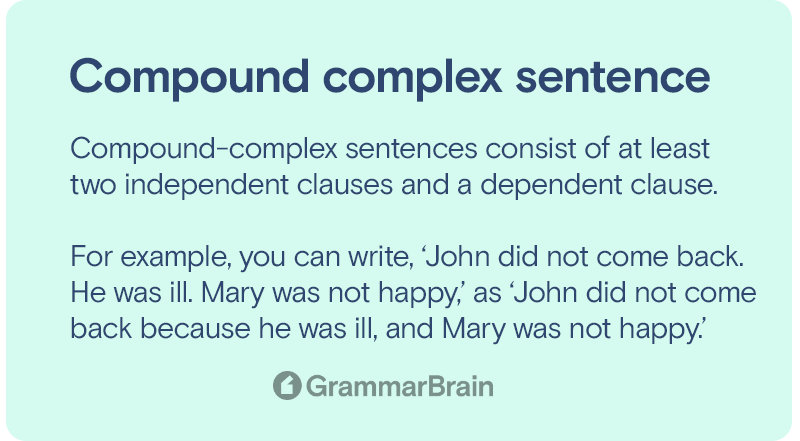What is a compound sentence? Compound sentences connect two independent clauses with a coordinating conjunction to create unified sentences while keeping the meaning intact.
The main idea behind creating compound sentences is to write faster and better. However, combining two or more clauses to form sentences requires a deeper understanding of language, grammar, and context than basic rules.
However, the question begs, what are compound sentences, and how do they work?

What is a Compound Sentence?
Compound sentences comprise two or more independent, related clauses. Independent clauses are standalone sentences that make sense even without a conjunction.
For example, when you write, ‘I have a pet dog. His name is Tom,’ both ‘I have a cat’ and ‘His name is Tom’ are independent clauses that make complete sense.
You can also use a conjunction, ‘and,’ to create compound sentences.
Consider this example. ‘I have a cat, and his name is Tom.’
Here, the comma between ‘I have a cat,’ and ‘his name is Tom’ is the separator, whereas, ‘and’ is the conjunction that combines the two independent clauses.
Alternatively, you can also use a semicolon. So, using a semicolon rather than a comma to separate the two sentences gives you, ‘I have a pet dog; his name is Tom.’
Since compound sentences comprise two or more independent clauses, you must use at least two verbs or subjects.
So, you can also write, ‘I have a pet dog whose name is Tom.’ However, if you want to use only one subject
The Four Types of Sentence Structures
There are many rules and requirements for forming sentences in English. These rules govern how different words, syllables, clauses, subjects, nouns, and verbs, are used to create sentences to express a thought or an idea. There are four ways to make sentences.
1. Simple Sentence
Simple sentences consist of an independent clause and use a subject and verb.
For instance, ‘I like coffee,’ or ‘Steve did not go to the party.’
2. Compound Sentence
Compound sentences can combine two or more independent clauses using a semicolon or conjunction. Each clause in this sentence is a separate sentence put together using coordinating words, such as ‘and,’ ‘but,’ or ‘for.’
For example, ‘I like coffee, but Mary likes tea,’ or ‘Our car broke down; we came last.’
3. Complex Sentence
Complex sentences comprise both dependent and independent clauses. A dependent clause consists of a subordinate conjunction or relative pronoun, a subject, and a verb. However, it does not convey the idea entirely as in the case of independent clauses.
For example, writing, ‘We missed our plane. We were late,’ as ‘We missed our plane as we were late,’ makes more sense since it conveys the required information through a single sentence.
Similarly, you can express, ‘He left in a hurry. He got a phone call’ as ‘He left in a hurry when he got a phone call.’
The phrases ‘We missed our plane’ and ‘We were late’ can be written together by adding a conjunction to make a meaningful sentence, such as ‘We missed our plane because we were late.’
Here, the word ‘because’ combines ‘We missed our plane’ with ‘We were late’ to make a single sentence without altering the meaning.

4. Compound-Complex Sentence
Compound-complex sentences consist of at least two independent clauses and a dependent clause.
For example, you can write, ‘John did not come back. He was ill. Mary was not happy,’ as ‘John did not come back because he was ill, and Mary was not happy.’
Similarly, you can express, ‘He left. He got a phone call. He came back later,’ as ‘He left after he got a phone call but came back later.’
The sentences, ‘John did not come back and ‘Mary was not happy’ are two independent clauses, and ‘He was ill’ are dependent clauses.
A dependent clause can also be a subordinate clause, as seen in this example.
Joining Independent Clauses in a Compound Sentence
You can also combine two independent clauses to make single, meaningful sentences.
Here’s an example. ‘John likes Marvel movies. He would probably watch it all if he could.’
When you combine the two clauses, you get, ‘John likes Marvel movies, and he would probably watch it all at a stretch if he could.’
You can also write, ‘John likes Marvel movies and would probably watch it all at a stretch if he could.’
In the first instance, a comma and coordinating conjunction separate the two independent clauses, whereas the second sentence is separated only by a coordinating conjunction.
How to Identify a Compound Sentence
You can identify compound sentences by looking at their coordinating conjunctions.
For example, the sentence, ‘Are you coming to school today, or would you like to stay at home?’ consists of two independent clauses, ‘Are you coming to school today?’ and ‘Would you like to stay at home?.’
You can join them to make a single sentence using the coordinating conjunction ‘or’ without changing the meaning.
Commas and Punctuation in a Compound Sentence
Two rules govern how you write compound sentences.
- You can put a comma before the coordinating conjunction.
For instance, ‘John went to the party, but Mary went to work, and I went home.’
As you can see, commas are placed before and after the sentence, ‘but Mary went to work.’
- You can also use semicolons to separate two independent clauses in a compound sentence.
For example, you can write, ‘Our car broke down. We came last,’ as ‘Our car broke down; we came last.’
Writing Compound Sentences
Writing compound sentences doesn’t have to be complicated as long as you know the basic grammatical rules and how to use them. However, if you still struggle to write compound sentences, here’s how you can go about it.
If there are three independent clauses, you must separate them using a comma. However, you don’t need to add a comma to connect two independent clauses.
For instance, you can write, ‘I study grammar. I chew gum. I’m all out of bubble gum,’ as I study grammar and chew gum, but I’m all out of bubble gum.’
However, if the sentence reads, ‘I study grammar. I chew gum,’ the compound form becomes ‘I study grammar and chew gum.’
In the above example, you can combine the clauses ‘I study grammar’ and ‘I chew gum’ to create ‘I study grammar and chew gum.’
Similarly, by combining, ‘I study grammar,’ I chew gum,’ and ‘I’m all out of bubble gum,’ the sentence reads, ‘I study grammar and chew gum, but I’m all out of bubble gum.’
You can also write, ‘I study grammar and chew gum, but I am all out of it.’ The three independent clauses, ‘I study grammar,’ ‘I chew gum,’ and ‘I am all out of bubble gum’ are combined using the conjunction, ‘but,’ to create this compound sentence.
Conclusion
Clauses are the foundation of English, and learning to use them correctly to form meaningful sentences can be challenging. There are different conjunctions that you can use to construct sentences. However, you might want to learn all you can about conjunctions and sentence structures.
You also need to know about the two types of independent and dependent clauses that can help you form sentences. Independent clauses are standalone phrases, whereas dependent clauses rely on independent clauses to give sentences their meanings.
Semicolons and commas separate sentences or clauses that follow each other.
So, like this, there are several rules that you may need to know when writing sentences. It isn’t hard as long as you know the rules and how to use them in different instances.
So, don’t forget to learn and use all the grammar rules that will help you write more meaningful sentences.
FAQs
What are the different ways of writing compound sentences?
There are three main ways of writing compound sentences.
- Semicolons.
- Commas and coordinating conjunctions.
- Transitional expressions.
For instance, you can write, ‘Megan cut the wood. Ryan stacked it,’ as ‘Megan cut the wood and Ryan stacked it.’
Similarly, you can combine these clauses using a semicolon, where the sentence reads, ‘Megan cut the wood; Ryan stacked it.’
Compound sentences may also consist of transitional expressions along with coordinating conjunctions.
For example, you can write, ‘Working all-day long got them hungry. They stopped to eat,’ as ‘Working all-day long got them hungry; so, they stopped to eat.’
Similarly, the sentence, ‘The task was hard. Kelly was up for it,’ can read, ‘The task was hard; Nevertheless, Kelly was up for it.’
What are the differences between simple and compound sentences?
As the name suggests, a simple sentence consists of an independent clause besides a subject and verb. In compound sentences, coordinating conjunction combine two or more independent clauses.
Compound sentences are longer than simple sentences and consist of more than one subject and predicate.
The clauses in compound sentences are separated by commas, or other such punctuation, which is not the same in simple sentences.
Why are compound sentences used?
Compound sentences help you write faster and better since they combine two or more independent clauses into single, unified sentences without changing the meaning.
You may use them to convey two or more ideas using a single sentence.
For instance, ‘I will go to school. After that, I will go to the gym.’
These are two different sentences or clauses that you can combine to form a single compound sentence using conjunctions to convey the same information.
So, you can write, ‘I will go to school and, later, to the gym.’ Here, the word ‘and’ is separated by a comma to convey the same information.
Inside this article
Fact checked:
Content is rigorously reviewed by a team of qualified and experienced fact checkers. Fact checkers review articles for factual accuracy, relevance, and timeliness. Learn more.
Core lessons
Glossary
- Abstract Noun
- Accusative Case
- Anecdote
- Antonym
- Active Sentence
- Adverb
- Adjective
- Allegory
- Alliteration
- Adjective Clause
- Adjective Phrase
- Ampersand
- Anastrophe
- Adverbial Clause
- Appositive Phrase
- Clause
- Compound Adjective
- Complex Sentence
- Compound Words
- Compound Predicate
- Common Noun
- Comparative Adjective
- Comparative and Superlative
- Compound Noun
- Compound Subject
- Compound Sentence
- Copular Verb
- Collective Noun
- Colloquialism
- Conciseness
- Consonance
- Conditional
- Concrete Noun
- Conjunction
- Conjugation
- Conditional Sentence
- Comma Splice
- Correlative Conjunction
- Coordinating Conjunction
- Coordinate Adjective
- Cumulative Adjective
- Dative Case
- Determiner
- Declarative Sentence
- Declarative Statement
- Direct Object Pronoun
- Direct Object
- Diction
- Diphthong
- Dangling Modifier
- Demonstrative Pronoun
- Demonstrative Adjective
- Direct Characterization
- Definite Article
- Doublespeak
- False Dilemma Fallacy
- Future Perfect Progressive
- Future Simple
- Future Perfect Continuous
- Future Perfect
- First Conditional
- Irregular Adjective
- Irregular Verb
- Imperative Sentence
- Indefinite Article
- Intransitive Verb
- Introductory Phrase
- Indefinite Pronoun
- Indirect Characterization
- Interrogative Sentence
- Intensive Pronoun
- Inanimate Object
- Indefinite Tense
- Infinitive Phrase
- Interjection
- Intensifier
- Infinitive
- Indicative Mood
- Participle
- Parallelism
- Prepositional Phrase
- Past Simple Tense
- Past Continuous Tense
- Past Perfect Tense
- Past Progressive Tense
- Present Simple Tense
- Present Perfect Tense
- Personal Pronoun
- Personification
- Persuasive Writing
- Parallel Structure
- Phrasal Verb
- Predicate Adjective
- Predicate Nominative
- Phonetic Language
- Plural Noun
- Punctuation
- Punctuation Marks
- Preposition
- Preposition of Place
- Parts of Speech
- Possessive Adjective
- Possessive Determiner
- Possessive Case
- Possessive Noun
- Proper Adjective
- Proper Noun
- Present Participle
- Prefix
- Predicate




